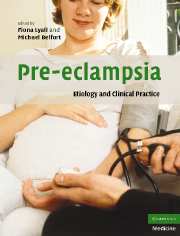Book contents
- Frontmatter
- Contents
- List of contributors
- Preface
- Part I Basic science
- 1 Trophoblast invasion in pre-eclampsia and other pregnancy disorders
- 2 Development of the utero-placental circulation: purported mechanisms for cytotrophoblast invasion in normal pregnancy and pre-eclampsia
- 3 In vitro models for studying pre-eclampsia
- 4 Endothelial factors
- 5 The renin–angiotensin system in pre-eclampsia
- 6 Immunological factors and placentation: implications for pre-eclampsia
- 7 Immunological factors and placentation: implications for pre-eclampsia
- 8 The role of oxidative stress in pre-eclampsia
- 9 Placental hypoxia, hyperoxia and ischemia–reperfusion injury in pre-eclampsia
- 10 Tenney–Parker changes and apoptotic versus necrotic shedding of trophoblast in normal pregnancy and pre-eclampsia
- 11 Dyslipidemia and pre-eclampsia
- 12 Pre-eclampsia a two-stage disorder: what is the linkage? Are there directed fetal/placental signals?
- 13 High altitude and pre-eclampsia
- 14 The use of mouse models to explore fetal–maternal interactions underlying pre-eclampsia
- 15 Prediction of pre-eclampsia
- 16 Long-term implications of pre-eclampsia for maternal health
- Part II Clinical Practice
- Subject index
- References
13 - High altitude and pre-eclampsia
from Part I - Basic science
Published online by Cambridge University Press: 03 September 2009
- Frontmatter
- Contents
- List of contributors
- Preface
- Part I Basic science
- 1 Trophoblast invasion in pre-eclampsia and other pregnancy disorders
- 2 Development of the utero-placental circulation: purported mechanisms for cytotrophoblast invasion in normal pregnancy and pre-eclampsia
- 3 In vitro models for studying pre-eclampsia
- 4 Endothelial factors
- 5 The renin–angiotensin system in pre-eclampsia
- 6 Immunological factors and placentation: implications for pre-eclampsia
- 7 Immunological factors and placentation: implications for pre-eclampsia
- 8 The role of oxidative stress in pre-eclampsia
- 9 Placental hypoxia, hyperoxia and ischemia–reperfusion injury in pre-eclampsia
- 10 Tenney–Parker changes and apoptotic versus necrotic shedding of trophoblast in normal pregnancy and pre-eclampsia
- 11 Dyslipidemia and pre-eclampsia
- 12 Pre-eclampsia a two-stage disorder: what is the linkage? Are there directed fetal/placental signals?
- 13 High altitude and pre-eclampsia
- 14 The use of mouse models to explore fetal–maternal interactions underlying pre-eclampsia
- 15 Prediction of pre-eclampsia
- 16 Long-term implications of pre-eclampsia for maternal health
- Part II Clinical Practice
- Subject index
- References
Summary
Introduction
Most well-described risk factors for pre-eclampsia are constitutional maternal attributes, such as primiparity, obesity, ethnicity, chronic hypertension, renal disease, etc. (Eskenazi et al., 1991; Saftlas et al., 1990; Sibai et al., 1995; Stone et al., 1994), or behavioral attributes such as contraceptive practices or smoking (or the lack thereof) (Klonoff-Cohen et al., 1989, 1993; Sibai et al., 1995). Residence at high altitude (>2700 m) is the only external environmental factor that, to date, has been consistently linked with an increased incidence of pre-eclampsia (Keyes et al., 2003; Mahfouz et al., 1994; Moore et al., 1982; Palmer et al., 1999). Far from being a problem limited to only isolated human populations, more than 40 million people reside at elevations >2700 m, with their numbers increasing rapidly (Moore et al., 1998). The primary effect of high altitude is lowered arterial oxygen tension (PO2). Thus, of the several competing hypotheses concerning the etiology of pre-eclampsia, the data from high altitude support that hypoxia (presumably of the fetoplacental unit) is an underlying cause or at the very least contributes to the development of the syndrome. The high-altitude data additionally support altered immunological function, impaired placentation (shallow invasion) and ischemia or ischemia/reperfusion injury as possible etiological factors. This review considers the impact of lowered maternal arterial PO2 on pregnancy physiology and the development of pre-eclampsia.
High altitude and hypertension during pregnancy
The first published report indicating that residence at high altitude may be associated with an increased risk for pre-eclampsia was by Colorado researchers in 1982.
- Type
- Chapter
- Information
- Pre-eclampsiaEtiology and Clinical Practice, pp. 195 - 208Publisher: Cambridge University PressPrint publication year: 2007



